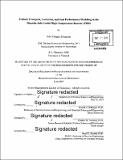Tritium transport, corrosion, and Fuel performance modeling in the Fluoride Salt-Cooled High-Temperature Reactor (FHR)
Author(s)
Stempien, John D. (John Dennis)
DownloadFull printable version (71.53Mb)
Other Contributors
Massachusetts Institute of Technology. Department of Nuclear Science and Engineering.
Advisor
Ronald G. Ballinger.
Terms of use
Metadata
Show full item recordAbstract
The Fluoride Salt-Cooled High-Temperature Reactor (FHR) is a pebble bed nuclear reactor concept fueled by tristructural isotropic (TRISO) fuel particles embedded in graphite spheres and cooled by a liquid fluoride salt known as "flibe" (7LiF-BeF2). A system of models was developed which enabled analyses of the performance of a prototypical pebble bed FHR (PB-FHR) with respect to tritium production and transport, corrosion, TRISO fuel performance, and materials stability during both normal and beyond design-basis accident (BDBA) conditions. A model of TRITium Diffusion EvolutioN and Transport (TRIDENT) was developed and benchmarked with experimental data. TRIDENT integrates the effects of the chemical redox potential, tritium mass transfer, tritium diffusion through pipe walls, and selective Cr attack by tritium fluoride. Systems for capturing tritium from the coolant were proposed and simulated with TRIDENT. A large nickel permeation window reduced the tritium release rate from 2410 to 800 Ci/EFPD. A large gas stripping system reduced tritium release rates from 2410 to 439 Ci/EFPD. A packed bed of graphite located between the reactor core and the heat exchanger reduced peak tritium release rates from 2410 to 7.5 Ci/EFPD. Increasing the Li-7 enrichment in flibe from 99.995 to 99.999 wt% reduced both the tritium production rate and the necessary sizes of tritium capture systems by a factor of 4. An existing TRISO fuel performance model called TIMCOAT was modified for use with PBFHRs. Low failure rates are predicted for modern uranium oxycarbide (UCO) TRISO fuels in a PBFHR environment. Post-irradiation examinations of surrogate TRISO particles determined that the outer pyrolytic carbon layer is susceptible to cracking if flibe were to freeze around the particles. Chemical thermodynamics calculations demonstrated that common constituents of concrete will not be stable in the event they contact liquid flibe. The chemical stability of fission products in reference to the coolant redox potential was determined in the event the TRISO UCO kernel is exposed to flibe during a BDBA. Noble gases (Kr and Xe) will escape the coolant. Cesium, strontium, and iodine are retained in the salt. All other important radionuclides are retained in the kernel or within the coolant system.
Description
Thesis: Ph. D., Massachusetts Institute of Technology, Department of Nuclear Science and Engineering, 2015. Cataloged from PDF version of thesis. Includes bibliographical references (pages 294-305).
Date issued
2015Department
Massachusetts Institute of Technology. Department of Nuclear Science and EngineeringPublisher
Massachusetts Institute of Technology
Keywords
Nuclear Science and Engineering.